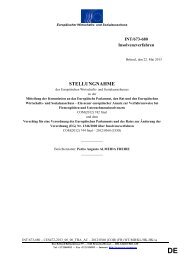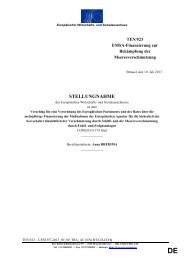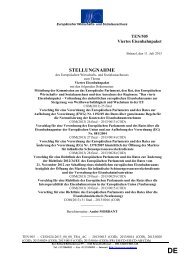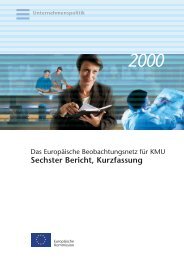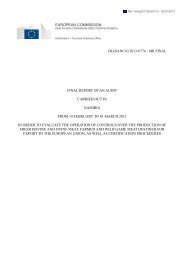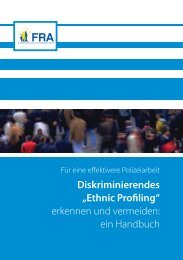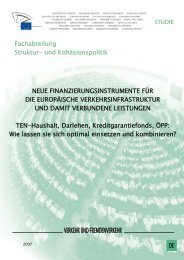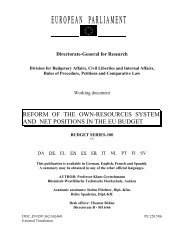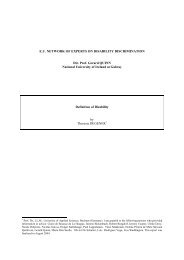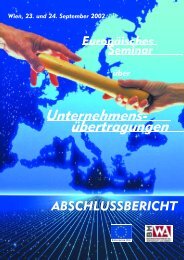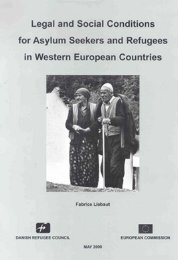I External aid
I External aid
I External aid
You also want an ePaper? Increase the reach of your titles
YUMPU automatically turns print PDFs into web optimized ePapers that Google loves.
Horizontal Issues<br />
Different channels<br />
are used to<br />
implement food<br />
security programmes.<br />
30<br />
4.2. Partnerships<br />
Direct Aid<br />
ANNUAL REPORT ON THE IMPLEMENTATION OF THE EUROPEAN COMMISSION’S EXTERNAL ASSISTANCE<br />
Close to half of the food security programme funding goes to<br />
direct <strong>aid</strong>. This permits the Commission to intervene in situ,<br />
either by funding government programmes via budget support,<br />
or else by giving direct support to private or public<br />
bodies at the local level. In both cases, this <strong>aid</strong> requires a<br />
funding agreement between the beneficiary government and<br />
the European Commission, specifying the implementation<br />
arrangements as well as the conditions to which this <strong>aid</strong> is<br />
submitted. Direct <strong>aid</strong> is offered only to structural intervention<br />
countries in which there is a constructive dialogue with the<br />
government, that enables the concerted implementation of a<br />
national food security strategy. This dialogue also implies<br />
varying degrees of co-ordination with the other intervening<br />
parties (donors, international and local NGOs, civil society<br />
organisations, private sector).<br />
Partnership<br />
In 2000, direct <strong>aid</strong> amounted to €196 million. This <strong>aid</strong> is<br />
concentrated in the structural intervention countries.<br />
Examples are given in the geographical sections.<br />
Indirect Aid<br />
Indirect <strong>aid</strong> is the second pillar of the food security programme.<br />
This permits the Commission to grant financial support<br />
to international organisations and non-governmental<br />
organisations in the food security programme intervention<br />
countries.<br />
The first beneficiary of indirect <strong>aid</strong> is the World Food Programme<br />
(WFP). Here community support is focused on emergency<br />
and rehabilitation programmes – the International<br />
Emergency Food Reserve (IEFR) and the protracted Relief and<br />
Rehabilitation Programme (PRRO) – for which the WFP can<br />
contribute all its added value. Examples of this occured in<br />
North Korea and in Ethiopia.<br />
© Paul Webber<br />
In 2000, the European Commission and FAO signed a co-operation<br />
agreement covering certain areas of Africa and Central<br />
Asia. This agreement is basically concerned with two<br />
approaches: developing and extending the Global Information<br />
and Early Warning System (GIAWS) and training southern<br />
countries in sectoral policies with a view to multilateral negotiations<br />
within the WTO.<br />
The United Nations Relief and Work Agency for Palestinian<br />
refugees (UNRWA) in the Middle East is the third international<br />
organisation to benefit from indirect <strong>aid</strong>. Its remit is to<br />
guarantee access to basic social services (including health<br />
and education) for Palestinian refugees in Jordan, Syria, the<br />
Lebanon and Palestine.<br />
NGOs in turn receive a significant share of the indirect <strong>aid</strong>,<br />
PARTNERSHIP (€ million)<br />
Direct 48%<br />
Partners Value<br />
Direct 196.06<br />
Indirect 213.65<br />
Other 48.70<br />
Total 458.41<br />
INDIRECT AID (€ million)<br />
Indirect Value %<br />
WFP 90.00 43%<br />
Euron<strong>aid</strong> (NGO) 48.05 22%<br />
NGO 60 28%<br />
UNRWA 13.80 6%<br />
FAO 1.80 1%<br />
Total 213.65<br />
Indirect 52%



